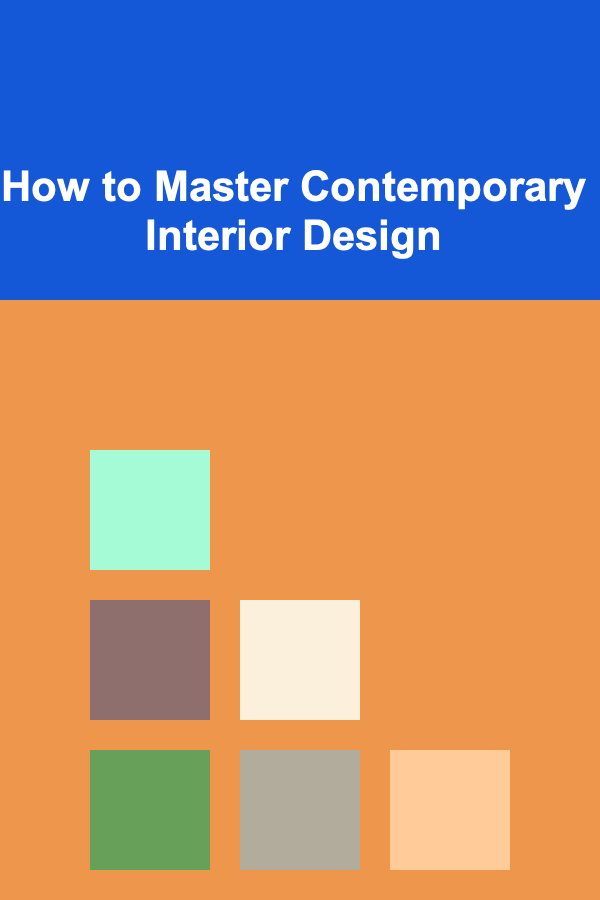
How to Master Contemporary Interior Design
ebook include PDF & Audio bundle (Micro Guide)
$12.99$7.99
Limited Time Offer! Order within the next:

Interior design has undergone significant transformations throughout the centuries. From ornate, classical styles to minimalist modernism, interior design trends continue to evolve, influenced by technological advancements, cultural movements, and the ever-changing needs of society. In today's world, contemporary interior design has become a widely popular approach, known for its clean lines, neutral color palettes, functional aesthetics, and the use of cutting-edge materials and furniture. Mastering contemporary interior design requires a deep understanding of its principles, history, and practical applications. This article will explore the essential elements of contemporary design, the evolution of the style, key principles, and actionable tips for mastering it in your own space.
Understanding Contemporary Interior Design
Contemporary interior design refers to the style and aesthetic that is popular in the present time. Unlike other design styles, which are often influenced by specific periods, movements, or historical references, contemporary design is constantly evolving. What makes contemporary design unique is its reflection of the current times and the ongoing changes in culture, technology, and lifestyle.
At its core, contemporary interior design embraces simplicity, functionality, and openness. The emphasis is on clean lines, spacious layouts, and the thoughtful integration of modern materials, lighting, and furniture. It is less about following rigid rules and more about creating a harmonious, balanced environment that reflects the lifestyle and preferences of the people inhabiting it.
The History and Evolution of Contemporary Design
Contemporary interior design has its roots in the mid-20th century, though its influence can be traced back to earlier design movements such as Modernism, Art Deco, and Minimalism. These styles laid the foundation for the sleek, practical, and forward-thinking approach that would define contemporary interiors.
Mid-20th Century Beginnings
The origins of contemporary interior design can be traced to the post-World War II era when designers and architects began to break away from traditional designs that emphasized ornamentation and heavy decoration. Instead, they embraced the principles of functionality, simplicity, and the efficient use of space. Influential movements like the Bauhaus school and Scandinavian design played key roles in shaping contemporary design, with an emphasis on clean, geometric lines, neutral colors, and the integration of new materials like steel, glass, and concrete.
The Rise of Minimalism
In the 1970s and 1980s, minimalist design gained popularity as an extension of modernist principles. Minimalism emphasized "less is more," focusing on functionality and simplicity while eliminating unnecessary elements and clutter. The movement championed open floor plans, neutral colors, and furniture that was streamlined and efficient, setting the stage for what would eventually evolve into contemporary design.
Technology and Sustainability
By the late 20th and early 21st centuries, advances in technology and materials had a significant impact on interior design. Contemporary design began to incorporate cutting-edge materials like glass, steel, and eco-friendly products. Sustainability became an important factor in the design process, with architects and designers considering the environmental impact of materials and energy consumption.
The fusion of new technologies, innovative materials, and a growing awareness of environmental concerns helped shape modern interior design, which continues to evolve today.
Key Principles of Contemporary Interior Design
To truly master contemporary interior design, it's crucial to understand and apply the key principles that define the style. These principles guide the creation of functional, aesthetically pleasing, and harmonious spaces.
1. Simplicity and Clean Lines
Contemporary interiors are characterized by simplicity. The design focuses on clean, unadorned lines and shapes. Furniture, fixtures, and finishes are typically sleek, straightforward, and without unnecessary ornamentation. The idea is to create open, uncluttered spaces that feel both modern and inviting.
For example, consider a contemporary living room with a neutral-colored sofa with simple, geometric shapes and clean lines, paired with minimalist coffee tables and unobtrusive light fixtures. Every element serves a purpose, with no excessive decoration.
2. Neutral Color Palettes
Neutral colors dominate contemporary design, creating a calm and soothing atmosphere. Shades of white, beige, gray, and black are commonly used as base colors for walls, flooring, and larger furniture pieces. These tones create a versatile backdrop that allows for experimentation with textures and accents in the form of textiles, artwork, and accessories.
While neutral colors are predominant, they can be complemented by pops of bold colors like navy blue, deep green, or even metallics like gold and copper to add depth and personality to a space.
3. Open Floor Plans
Open floor plans are a hallmark of contemporary interior design. The idea is to create an open, fluid space where rooms flow into one another, allowing for a sense of spaciousness and connectivity. This layout is particularly beneficial in modern living, where the boundaries between living, dining, and kitchen areas have become less rigid.
An open floor plan promotes flexibility, making it easier for people to move between spaces and interact with each other. It also enables the use of light and air circulation, making spaces feel larger and more open.
4. Emphasis on Functionality
Contemporary design prioritizes functionality, with furniture and layouts designed to support the activities and lifestyles of the inhabitants. Every piece in a contemporary home is chosen for its utility as much as its form. Whether it's multifunctional furniture or spaces designed for socializing, contemporary design is all about practicality without sacrificing style.
For instance, a contemporary living room may feature modular seating, a large entertainment unit with integrated storage, and a spacious layout that encourages conversation and relaxation.
5. Use of Natural Light
Natural light is another key feature of contemporary interior design. Large windows, glass doors, and open spaces help flood the interiors with natural light, creating an airy and bright atmosphere. The careful positioning of windows, skylights, and glass walls helps to blur the lines between indoor and outdoor spaces, enhancing the connection to the environment.
Maximizing natural light not only improves the aesthetic appeal of a room but also has practical benefits, such as reducing energy consumption during the day and creating a more sustainable environment.
6. Sustainable and Eco-friendly Materials
Sustainability is a growing concern in contemporary design. Designers are increasingly mindful of the environmental impact of the materials they use, opting for eco-friendly options that minimize harm to the planet. Materials like bamboo, reclaimed wood, cork, and recycled glass are frequently incorporated into contemporary designs.
Sustainable interior design not only benefits the environment but also creates a healthier living space. Materials that emit fewer volatile organic compounds (VOCs), such as low-emission paints, contribute to better indoor air quality.
How to Incorporate Contemporary Design in Your Home
Mastering contemporary interior design means taking the principles and applying them to your own living space. Here's how to bring contemporary style into your home:
1. Start with a Neutral Foundation
Begin by selecting a neutral color palette for the walls, floors, and large furniture pieces. Lighter tones like whites, grays, and creams can help make a space feel more open and airy. You can then introduce pops of color through accessories like throw pillows, rugs, and artwork.
2. Invest in Functional Furniture
Contemporary design places a heavy emphasis on functionality, so choose furniture that meets your needs while looking sleek and stylish. Opt for clean-lined furniture with minimal ornamentation. Modular sofas, multifunctional coffee tables, and storage units with hidden compartments are great choices.
3. Embrace Open Spaces
Try to create an open flow in your living areas. Remove unnecessary walls and partitions that separate rooms, and replace them with open archways or sliding glass doors. Open floor plans create a sense of spaciousness and allow for better interaction between family members or guests.
4. Add Natural Elements
Incorporate natural materials and textures into your space to create balance and warmth. Use wooden furniture, natural stone, or plants to introduce organic elements into an otherwise sleek, modern space. The contrast between natural textures and contemporary materials adds depth and character to the design.
5. Maximize Natural Light
Make the most of natural light by adding large windows, skylights, or glass doors. Consider removing heavy curtains or opting for sheer blinds that allow sunlight to filter through while maintaining privacy. Well-placed mirrors can also reflect natural light and brighten up darker areas of the room.
6. Sustainable Choices
When selecting materials and furniture, prioritize sustainability. Choose products made from recycled materials, and look for certifications like FSC (Forest Stewardship Council) for wood and GREENGUARD for low-emission products. By being mindful of your choices, you can create a home that is not only contemporary but also eco-friendly.
Conclusion
Mastering contemporary interior design requires a deep understanding of its principles and how to apply them effectively to create a functional, stylish, and harmonious living space. By embracing simplicity, open floor plans, neutral colors, and sustainable materials, you can design an interior that is both timeless and adaptable to the ever-changing trends of the modern world. Whether you're redesigning a single room or revamping your entire home, contemporary interior design offers endless opportunities to create a space that reflects your personality, lifestyle, and appreciation for modern aesthetics.

How to Handle Renovation Stress and Stay Organized
Read More
The Tax Consultant's Guide: Mastering Tax Strategies for Individuals and Businesses
Read More
How to Master Public Speaking for Panel Discussions
Read More
How to Market Your Blockchain Project to a Global Audience
Read More
How to Create a Cultural Immersion Travel To-Do List
Read More
How to Automate Cloud Infrastructure Provisioning
Read MoreOther Products

How to Handle Renovation Stress and Stay Organized
Read More
The Tax Consultant's Guide: Mastering Tax Strategies for Individuals and Businesses
Read More
How to Master Public Speaking for Panel Discussions
Read More
How to Market Your Blockchain Project to a Global Audience
Read More
How to Create a Cultural Immersion Travel To-Do List
Read More